Hybrid variety from Japanese breeders - tomato "Pink Paradise F1"
Every gardener knows how much labor and time it takes to produce a bountiful tomato crop. It is not easy to grow this vegetable in our country, especially in central Russia and the Siberian region: bushes and fruits of solanaceous plants often infect plant parasites, viruses and fungi, and weather conditions do not always allow for a full harvest.
Knowing the difficulties of growing tomatoes, breeders are constantly developing new varieties and hybrids that are resistant to pests and diseases. The Japanese firm "Sokata" succeeded in this. In 2009, she released a hybrid tomato variety Pink Paradise, which is distinguished by its unpretentiousness and ease of care.
The content of the article
Description of the variety
Tomato variety Paradise f1 is a hybrid. It first went on sale in 2009, but this tomato appeared on the markets of our country much later.
It is interesting! Hybrids are bred by crossing several different varieties. Breeders are trying to invest in such crops all the best qualities of the "mother" plants.
Culture is indeterminate. It has constant growth and can reach a height of 2 m, and this must be taken into account when growing a tomato in greenhouses and greenhouses. For Russian conditions, the manufacturer recommends growing the variety there - this will facilitate the care of the tomato and give a rich harvest.
Planting these tomatoes in open ground is not excluded. In this case, tomato bushes will need more careful care.
Reference.Even an amateur gardener can handle the care of this hybrid.
A photo of this tall bush clearly demonstrates the characteristics of the variety.
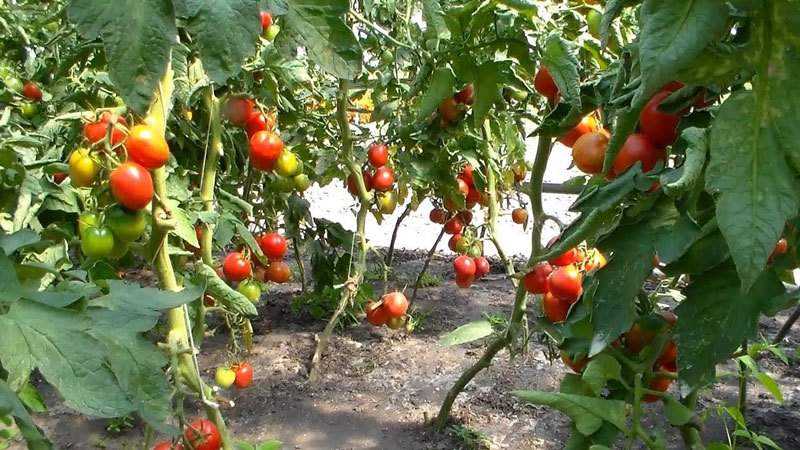
Characteristics
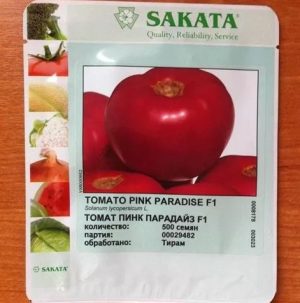 Pink Paradise is a hybrid variety of pink tomato. It is distinguished by excellent taste and large, almost identical fruits, with an average amount of pulp and four chambers.
Pink Paradise is a hybrid variety of pink tomato. It is distinguished by excellent taste and large, almost identical fruits, with an average amount of pulp and four chambers.
Tomatoes of this variety are best for eating raw, but they are also used for harvesting for the winter. Therefore, Pink Paradise tomatoes can be called universal.
It is interesting! The f1 designation indicates that Pink Paradise is a first generation hybrid.
The main feature and advantage of the Japanese tomato is its resistance to many pests and diseases. This allows you to reduce the amount of plant treatment you need to produce a high quality, healthy crop.
Characteristics of Pink Paradise
Before buying Pink Paradise tomatoes, you need to familiarize yourself with the features and characteristics of this variety.
Characteristics and description of the variety:
| Parameter | Indicators |
| Bush type | Indeterminate... A shrub with constant growth. It can reach 2 m. The stems are powerful, with a lot of greenery. |
| Growing method. | Recommended to grow in film greenhouses. It is possible to grow in the open field, with the risk of deterioration of the qualities invested in the hybrid. |
| Yield | From one square. m, on average, 4-6 kg of crop are harvested. With proper care, performance can be higher. |
| Fruit | Pink with a uniform shade of skin and pulp. Juicy, medium fleshy. They have a round, slightly flattened shape with slight ribbing at the base. The taste is sweetish. The skin is delicate but tough. The fruits are large, four-chambered and can reach from 150 to 200 g. |
| Transportability | Excellent. The fruits can be stored for 2-3 weeks.They do not crack and do not lose their presentation. |
| Ripening terms | Mid-season hybrid variety. The first crop appears 100-120 days after planting. |
| Disease resistance. | The hybrid is not susceptible to tobacco mosaic virus, brown and gray spot, cladosporiosis, root nematode, fusarium wilt, verticillium wilt. |
Growing seedlings
If you decide not to buy ready-made seedlings from experienced gardeners, but to grow bushes from seeds on your own, study the basic rules for such work. High-quality seedlings are the key to a healthy plant and a rich harvest.
Seedlings are sown at the end of February. Experienced gardeners are advised to do this according to the lunar calendar.
Preparing the seeds
Before you start working with seeds make sure that their expiration date has not expired - old material has low germination rates.
Seed preparation:
- Go through the planting material. Discard damaged seeds covered with mold and fungus.
- There is no need for seed disinfection. The manufacturer makes all the necessary manipulations to protect the material from diseases.
- To accelerate seed germination and increase their germination, treat them with a growth stimulant. The material is soaked in a special liquid (for example, "Epin") for 12 hours.
- After soaking, remove the seeds that have floated. The chances that they will sprout are low.
Advice! If you sow seeds not soaked in a growth promoter, they will also sprout. But the germination of the material in this case will be slower.

Choosing a container and soil
The choice of container for germinating seeds does not really matter. For these purposes, it is most convenient to use long plastic trays or wooden boxes. Some gardeners plant seedlings in cut-off five-liter bottles, juice containers.
When the seedlings germinate, each plant is planted in individual containers. For these purposes, it is better to use small peat pots, disposable cups, etc.
To grow seedlings, you need a properly prepared soil mixture.
There are two ways to prepare it:
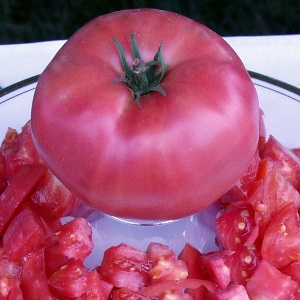 Purchase ready-made mixture in a specialized store. Such soil has an ideal composition, which includes substances necessary for the full development of seedlings.
Purchase ready-made mixture in a specialized store. Such soil has an ideal composition, which includes substances necessary for the full development of seedlings.- Prepare the soil yourself - this is a more budgetary and reliable option. To make fertile soil, mix two parts peat with one part turf and one part humus. You can add ash and a little superphosphate to this mixture.
Advice! In order to save money, gardeners mix purchased and self-prepared soil in equal proportions.
Both purchased and homemade soil can contain insects and bacteria that are dangerous to seedlings. Therefore, before use, the earth must be treated with a light pink solution of potassium permanganate.
Sowing seeds
The seeds are planted in a large container. They are buried 1.5 cm into the ground.
Cover the seedlings with foil. The container is placed in a place well-lit by sunlight, for example, on a windowsill. The optimum temperature for growing is +25 degrees.
To avoid stagnant moisture, the seedlings must be regularly ventilated. To do this, it is enough to open the film for several hours in a warm part of the day.
Seedling growing rules
Seed germination and plant health depend on the correct care of seedlings. There are several important rules for the tomato move.
Seedling growing rules:
- The soil is moistened as it dries, always through a spray bottle. It is important to use water at room temperature.
- It is necessary to constantly maintain the optimum temperature and moisture level for the plants.
- When real leaves appear on the tomatoes, they are seated in individual pots. It is better to use peat containers.
- When the transplanted plants take root, feed them with complex fertilizers.
- Seedlings in separate pots are watered from a watering can.The frequency of watering depends on the rate of soil drying.
- Two weeks before planting seedlings in open ground or a greenhouse, it is necessary to harden it. To do this, pots with plants are put out on the street every day during the warm season. First, the tomatoes are taken out into fresh air for a couple of hours, then this time is gradually increased.
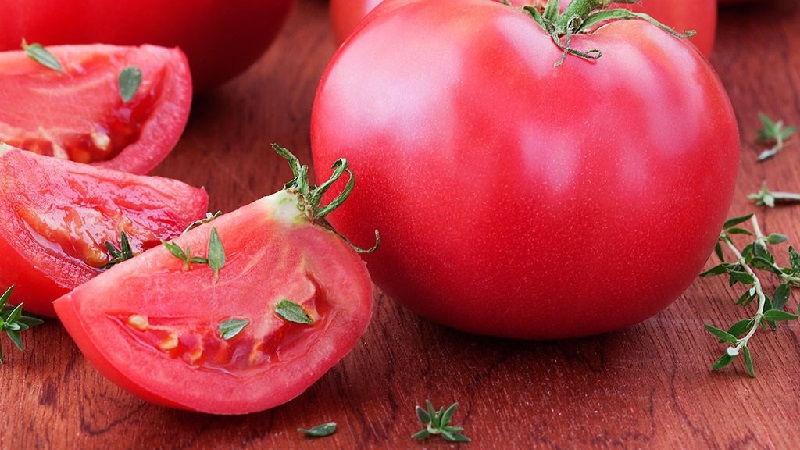
Growing tomatoes
For Pink Paradise, the manufacturer recommends using greenhouses. A greenhouse in the garden can also be a suitable option for Japanese tomatoes.
Advice! If you want to get a good harvest, then it is better to grow the seedlings yourself. Unscrupulous sellers may sell cheaper varieties under the guise of an expensive Pink Paradise hybrid.
Landing in the ground
You need to plant tomatoes in May, in the last decade. At this time, the soil has time to warm up to the required temperature.
For better growth of tomatoes, ash and compost are added to the holes in which they will be planted. Deepening of plants is carried out up to the first cotyledonous petals in order to form additional roots.
It is important to observe the distance between the bushes - 60 cm and 40 cm between the rows. The tomato stem is tied to a wooden support.
The first watering of plants is done a week after planting seedlings in the ground. At the same time, you can make the first feeding.
Advice! If you are planting tomatoes in open ground, then at first it is better to keep the plants under the film, periodically airing them.
Care rules
Tomatoes are grown in one or two stems. In the first case, the crop will appear two weeks earlier, and in the second, more fruits will be obtained.
Rules for feeding pink Paradise tomatoes:
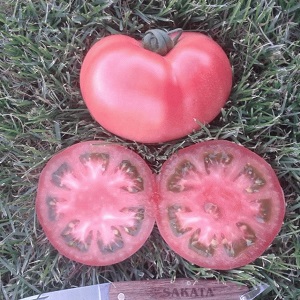 The first time tomatoes are fed a week after they are planted in the greenhouse. For this, nitrogen fertilizers are used.
The first time tomatoes are fed a week after they are planted in the greenhouse. For this, nitrogen fertilizers are used.- Potash and phosphorus fertilizers are used to increase the quantity and quality of ovaries. Two weeks later, a second feeding is introduced.
- Can also produce foliar feeding... For this use boric acid.
Paradise Peak - self-pollinated tomatoes. To speed up the fruit setting, the bushes need to be shaken gently every morning.
It is important to pinch the bushes. Otherwise, instead of a bountiful harvest, you will get a lot of greenery. After forming six full-fledged brushes, you need to limit the growth points.
In the process of pinching, the lower leaves and regrown shoots are removed. This should be done regularly and carefully.
Water the tomatoes regularly, without flooding the bushes. On the day of removal of leaves and shoots, watering is not performed, in order to avoid contamination of injured areas.
The nuances of growing Pink Paradise tomatoes in a greenhouse and in the open field
The manufacturer recommends growing Pink Paradise in greenhouses or greenhouses. Under these conditions, the plants will give the best yield.
Caring for a Japanese tomato in greenhouses is not associated with any difficulties. All that is required from the gardener is regular watering, garter and pinching.
Planting Pink Paradise tomatoes in open ground is possible. The manufacturer warns that in this case it is likely that the hybrid quality will deteriorate.
In soil conditions, it is necessary to bring the conditions as close as possible to greenhouse conditions. To do this, it is advisable to cover the bushes at night with a film, creating a greenhouse effect.
The risks of late blight infection in the case of growing Pink Paradise in the open field increase. Therefore, even underripe fruits are harvested in rainy weather.
Farmers who have tried both methods of growing tomatoes say that the hybrid gives the most abundant harvest when grown in a greenhouse. In such conditions, it is rarely affected by fitovtora.
Pests and diseases
Pink Paradise is resistant to most plant diseases, which significantly reduces the number of treatments required. Therefore, even a beginner should not have any problems with caring for this variety.
Plants can infect harmful insects.Therefore, the bushes need to be regularly inspected and collected garden pests. To scare them away, spray the tomatoes with soapy water.
Regular removal of weeds will not only ensure normal growth of the plant, but also protect it from the bear. Slugs are afraid of a composition made from a spoonful of red pepper added to a bucket of water.
To avoid plant contamination late blight they, starting in July, are treated every two weeks with a systemic fungicide. Two weeks before harvesting, the procedures are stopped.
Collection and use of fruits
Harvesting begins after the first fruits ripen. Regularly in the morning, you need to remove all ripe fruits from the bush with scissors. Harvesting continues down to low temperatures.
In rainy weather, large green fruits can also be harvested. With a stalk, they will ripen at home.
Pink Paradise pink tomatoes have a sweet taste. Mostly they are used fresh. They also make mashed potatoes and tomato juice.
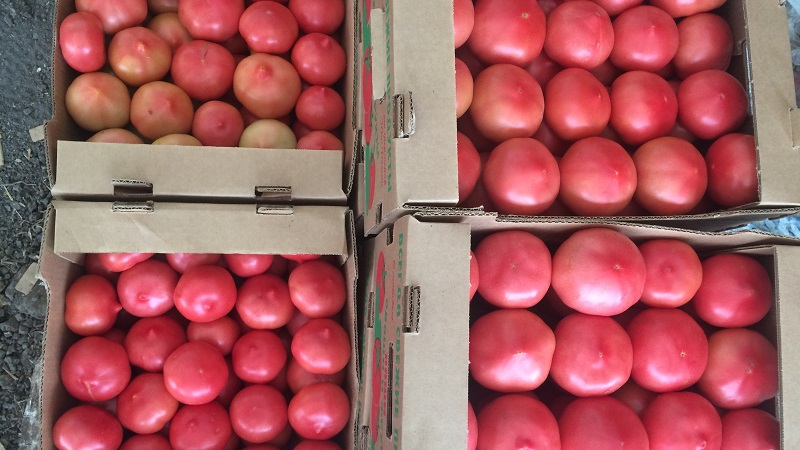
Pros and cons of Pink Paradise
Benefits of Pink Paradise:
- large fruits;
- great taste;
- resistance to plant diseases;
- almost the same fruit size;
- the possibility of growing both in the greenhouse and in the open field.
Disadvantages of a hybrid:
- average yield;
- inability to use seeds from fruits;
- the need for garter and pinching.
Farmers reviews
Reviews about Pink Paradise tomato are controversial:
Savinov Oleg, Klin: “I have been growing Pink Paradise for several years now. Excellent yield, amazing taste, unpretentious care. What else does a novice gardener need? "
Copper Natalia, Belgorod: “I didn't like Pink Paradise very much. The yield is average. I'm from 1 sq. meters received 4 kg, the same Bull heart gives more. "
Conclusion
If you are a fan of sweet pink tomatoes, then Pink Paradise tomato is just what you need. The hybrid gives large tasty fruits of the same size, which are suitable both for fresh consumption and for preparing juices and ketchups for the winter.
Even a novice gardener can handle the cultivation of these tomatoes. Timely watering, garter and pinching is all that is needed for an unpretentious Japanese variety that is not afraid of plant diseases. If you don't have a greenhouse, it doesn't matter. Gardeners grow Pink Paradise in the open field. True, in this case the harvest will be less plentiful, and more effort will have to be spent on caring for the hybrid.
Watch a video about Pink Paradise tomato: